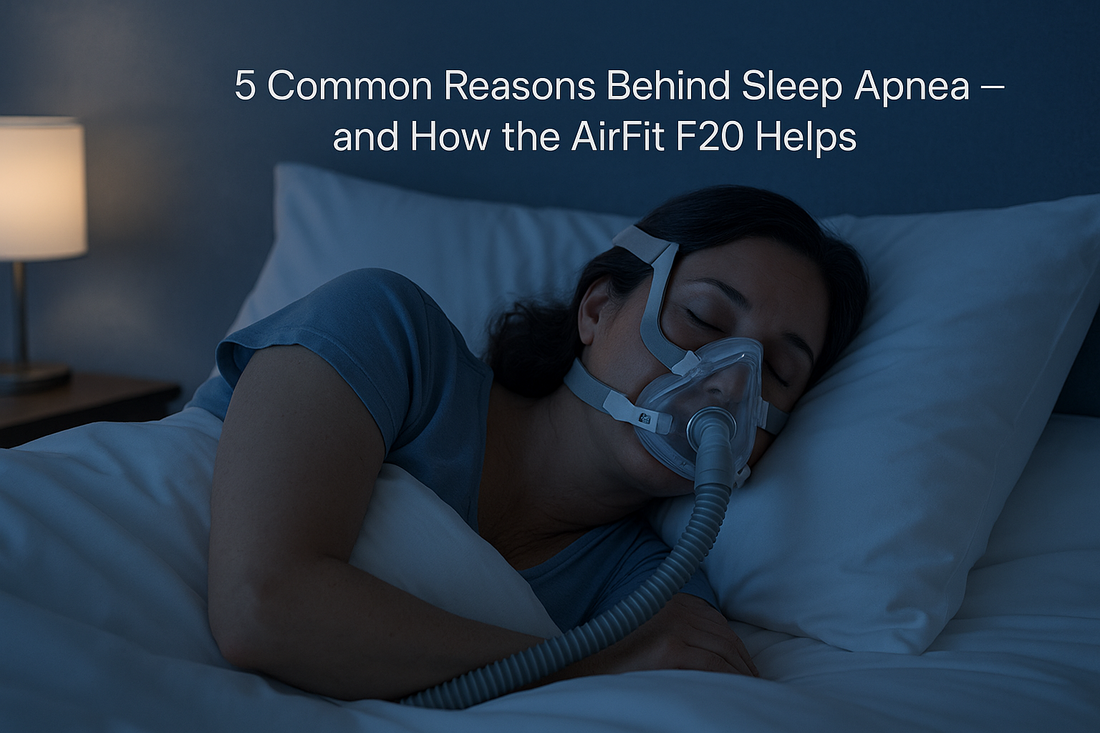
5 Common Reasons Behind Sleep Apnea — and How the AirFit F20 Helps
Share
Sleep apnea is more than just snoring. It's a serious sleep-related breathing disorder that can interrupt your breathing many times each night — leaving you tired, less alert, and at greater risk of health issues. The good news? Understanding what triggers sleep apnea and working with the right equipment can make a big difference. In this article, we’ll explore five common reasons behind sleep apnea — and show how the AirFit F20 full-face mask plays an important role in managing it.
What is Sleep Apnea?
In simple terms, sleep apnea occurs when your breathing temporarily stops (apnea) or becomes very shallow (hypopnea) during sleep. The most common form is Obstructive sleep apnea (OSA), where the upper airway becomes partially or completely blocked during sleep. These pauses in breathing may wake you (often without you even remembering), fragmenting your sleep and lowering oxygen levels in your blood.
Over time, untreated sleep apnea can lead to serious consequences: daytime fatigue, cognitive difficulties, elevated blood pressure, heart problems, and more.
Let’s now look at five of the most common underlying causes.
1. Obesity (especially around the neck and upper airway)
One of the strongest risk factors for obstructive sleep apnea is excess weight. Fat deposits around the neck, throat and tongue can narrow the airway and increase its tendency to collapse during sleep.
When the airway becomes narrower, any slight relaxation of the throat muscles (which naturally happens during sleep) can lead to partial or full blockage — causing the breathing interruptions that characterise sleep apnea.
What to do:
- Losing weight (if appropriate) can reduce fat around the neck and improve airway space.
- Maintain healthy sleep-hygiene, avoid heavy meals close to bedtime, and limit alcohol/sedatives which can relax throat muscles further.
2. Enlarged Tonsils or Adenoids (and a naturally narrow airway)
For both children and adults, having enlarged tonsils or adenoids can reduce airway size and increase the risk of collapse during sleep.
Similarly, some people are born with anatomical features (narrow throat, larger tongue, or certain jaw/face shapes) that predispose them to airway obstruction.
What to do:
- In children: a sleep specialist, ENT or paediatrician can assess if enlarged tonsils/adenoids are contributing and whether removal is appropriate.
- In adults: nasal/airway evaluation may be indicated; speak to your sleep physician about anatomical factors.
3. Nasal Congestion (and airflow resistance through the nose)
Chronic nasal congestion — whether from allergies, a deviated septum, sinusitis or other causes — makes it harder to breathe through the nose. This forces more mouth-breathing, increases airway resistance, and raises the likelihood of airway collapse during sleep.
When the nose is blocked, the throat muscles have to work harder, the airway collapsibility increases, and the risk of apnea rises.
What to do:
- Treat underlying nasal issues: allergy management, nasal sprays, decongestants (as prescribed), or ENT review for structural issues.
- Consider using a humidifier or nasal dilator to improve airflow.
- Avoid sleeping purely on your back (see the next point) if nasal breathing is compromised.
4. Sleeping on Your Back (supine position)
Your sleeping position can influence airway collapse. When you sleep on your back, your tongue and soft tissues in the throat may fall backward and obstruct the airway more easily.
Side-sleeping or elevating your head slightly can help reduce airway collapse. Some devices and pillows help encourage side-sleeping.
What to do:
- Try to sleep on your side rather than your back. Placing a tennis ball in a back-pocket shirt or using a positional pillow can help.
- Elevate the head of the bed slightly (via blocks or adjustable bed) to reduce gravitational collapse of the airway.
- Use your CPAP/mask consistently every night (see section below) so the therapy can take maximum effect regardless of position.
5. Age & Genetics (airway structure, muscle tone, and inherited risk)
As we age, changes in muscle tone (including the throat muscles), fat distribution and airway tissue elasticity can increase the risk of sleep apnea. Also, genetics play a part — your inherited airway shape, jaw/face structure and muscle responsiveness all affect risk.
In short: even if you don’t fit the “classic” profile (e.g., overweight, snorer), you can still develop sleep apnea because of anatomical/family factors.
What to do:
- If you have a family history of sleep apnea, snoring, or related issues (high blood pressure, stroke), talk to a sleep specialist early.
- Lifestyle still matters: even with inherited risk, maintaining muscle tone (via regular exercise), avoiding heavy alcohol/sedatives before bed and using therapy as prescribed can mitigate the risk.
How the AirFit F20 Helps with Sleep Apnea
Now that we’ve covered major reasons behind sleep apnea, let’s focus on how the AirFit F20 (full-face mask) helps make therapy effective and comfortable.
What is the AirFit F20?
The AirFit F20 is a full-face CPAP mask made by ResMed. It covers both the nose and mouth, making it a good choice for:
- Mouth breathers
- Those with nasal congestion or blockage
- Higher-pressure therapy users
- Side or back sleepers who change positions frequently
Key features of the mask include:
- InfinitySeal cushion — designed to adapt to a variety of facial structures and maintain a secure seal even when you move during sleep.
- QuietAir venting — reduces mask noise to about 21 decibels (about a whisper) for a more peaceful sleep environment.
- Magnetic headgear clips & quick-release elbow — make it easier to put on/take off and disconnect at night without removing the mask entirely.
- Designed to “fit most” — internally shown to fit around 97% of users in studies.
Why this matters
Let’s connect this back to the causes of sleep apnea we discussed:
- Since many sleep apnea patients breathe through their mouth (especially if nasal congestion is present) or need higher pressures, a full-face mask like the AirFit F20 ensures both mouth and nose are covered rather than relying only on nasal breathing.
- A secure seal is crucial — if leaks occur (common with mouth movement, side sleeping, shifting positions) then therapy pressure drops, the airway may still collapse, and the benefit of CPAP is reduced. The InfinitySeal helps maintain the seal under changing conditions.
- Comfort and ease of use are vital for adherence. Sleep apnea therapy only works if you use it consistently every night. A mask that’s easier to wear, less intrusive, quieter and easier to disconnect can improve likelihood of consistent use.
- If you’re a side-sleeper, move around a lot, or switch positions, the design of the mask supports movement without losing seal — which makes your underlying causes (back-sleeping, positional collapse) less likely to undermine therapy.
Tips for best results with your mask
- Make sure you are sized properly (small, medium or large cushion) and that the mask is fitted by a trained provider. Poor fit = leaks = reduced benefit.
- Clean the mask daily (mild soap + warm water) and replace cushions/headgear as recommended. Dirty or worn parts reduce seal and comfort.
- Use your therapy every night — even naps. Skip nights reduce overall benefit and allow underlying airway collapse to persist.
- Combine mask use with lifestyle changes: weight management, positional sleeping (avoid back), nasal care, limit alcohol/sleeping pills. The mask helps therapy, but underlying causes still deserve attention.
- Monitor your data (many CPAP machines report usage, mask leaks, AHI (apnea/hypopnea index) etc) and stay in touch with your sleep physician. If you still experience symptoms (daytime tiredness, snoring, gasping) despite use, you may need mask/cushion reevaluation or pressure adjustments.
Conclusion
Sleep apnea is a layered condition: it’s not just snoring, and it’s not always obvious. It may stem from excess weight, enlarged tonsils/adenoids, nasal blockages, sleep-position, age or inherited airway anatomy. Recognising these causes gives you power to act — not only through lifestyle changes but also through consistent therapy.
A mask like the AirFit F20 offers features designed to overcome some of the key obstacles in therapy: mouth-breathing, mask leaks, comfortable side/back sleeping, and adherence. When you pair a good mask with overall healthy sleep habits and medical oversight, you’re putting yourself in the best position to treat sleep apnea effectively.
If you suspect you have sleep apnea (for example, you wake exhausted, you snore loudly, your partner notices breathing pauses, or you have associated conditions like high blood pressure, diabetes or heart disease), then don’t wait. Talk to a sleep specialist. Get assessed. And if indicated — find a mask that fits well and commit to using it night after night.
Sleep well, breathe well, and wake up refreshed.
